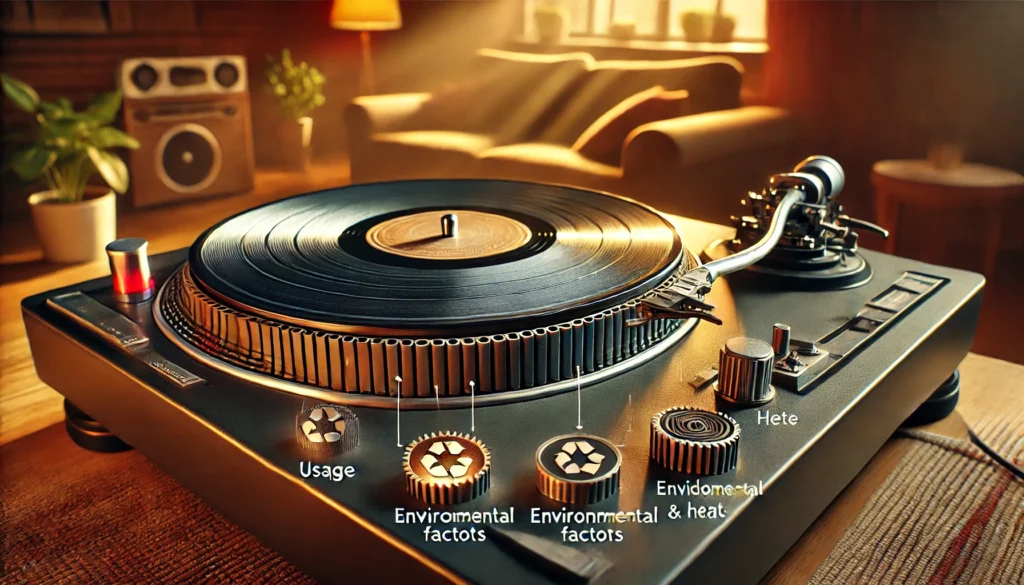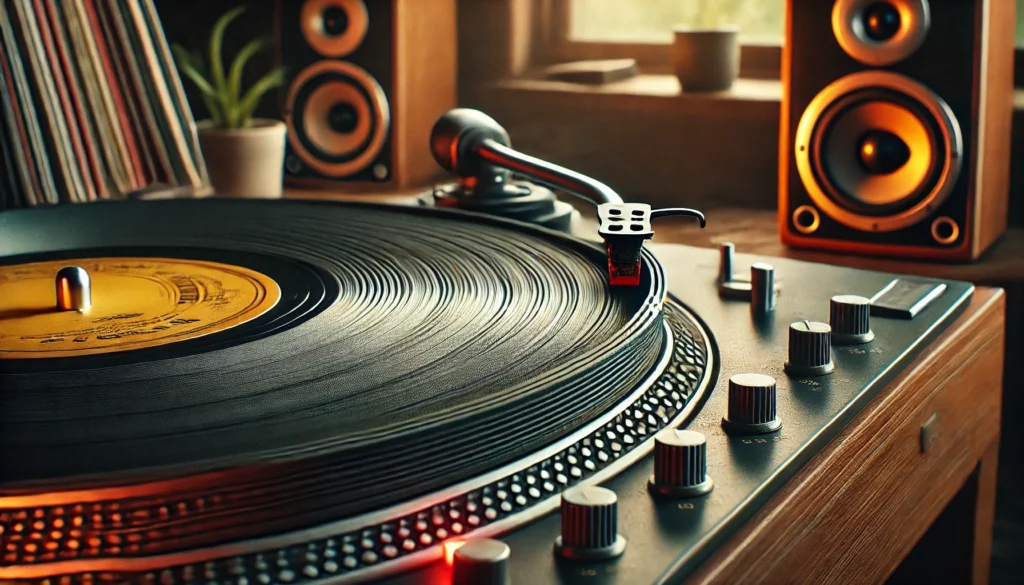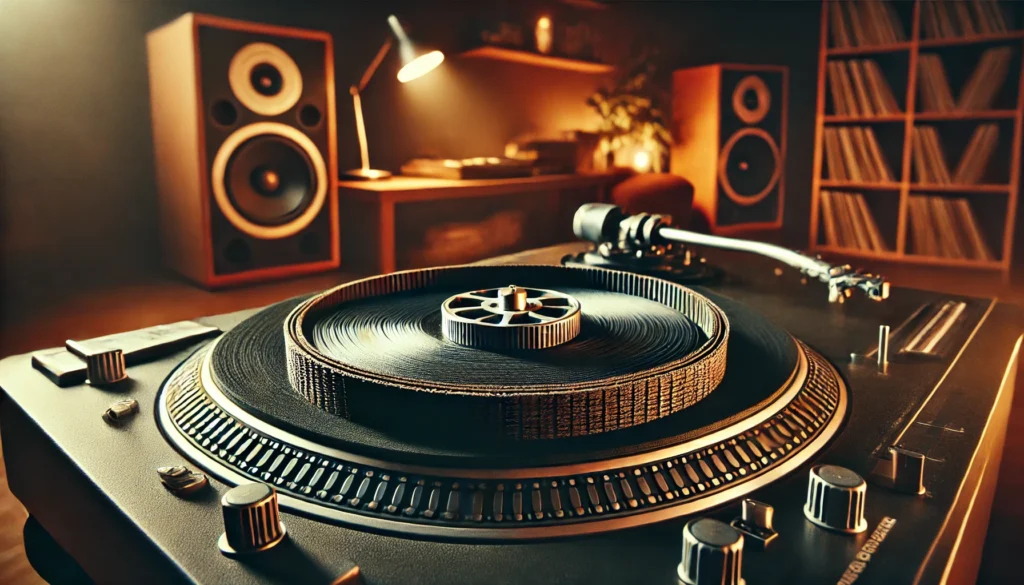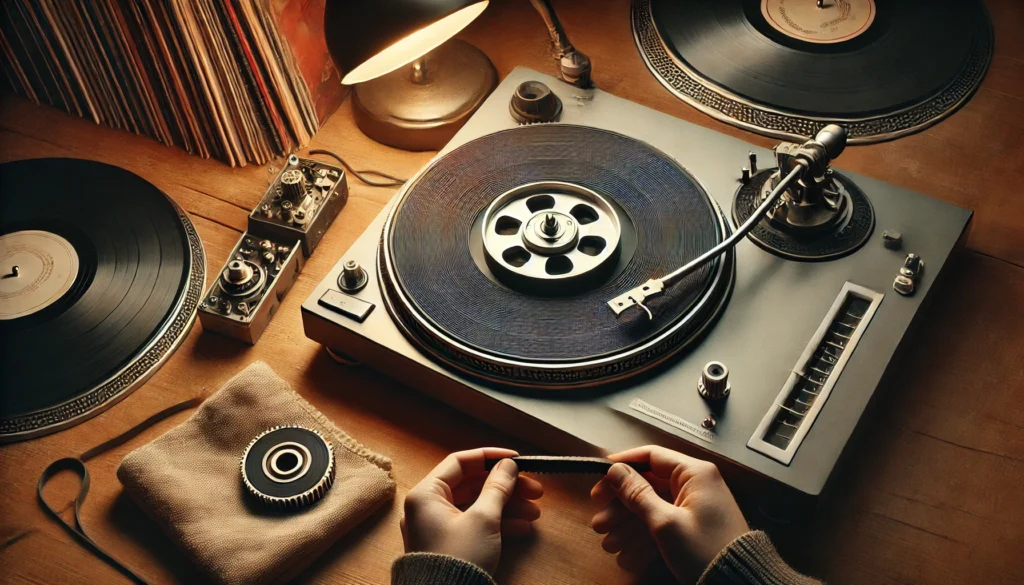Alright, vinyl junkies, gather ’round! We’re about to dive into a topic that’s gonna make or break your listening experience: turntable belts.
Yeah, I know, it’s not the sexiest part of your setup, but trust me, it’s a game-changer.
I’ll never forget the day I learned this lesson the hard way. Picture this: I’m hosting a listening party, all set to impress my audiophile buddies with my pristine copy of “Rumors” by Fleetwood Mac.
I drop the needle, and instead of Stevie Nicks’ velvety vocals, all we hear is a sad, warbling mess. Talk about a mood killer! Turns out, my turntable belt had given up the ghost without me even noticing.
So, how long does one of these bad boys actually last? Grab your favorite beverage, ’cause we’re about to get into the nitty-gritty of turntable belt lifespan.
By the time we’re done, you’ll be looking at your record player in a whole new light!
How Long Does A Turntable Belt Last?

On average, a turntable belt lasts between 3 to 5 years with regular use. However, high-quality belts made from materials like silicone can last up to 10 years, while cheaper rubber belts might need replacement after just 1-2 years.
Factors such as usage frequency, storage conditions, and overall turntable quality significantly influence a belt’s lifespan. Regular maintenance and proper care can extend its life, but it’s generally recommended to inspect your belt annually and replace it every 3-5 years to ensure optimal sound quality.
Now, that’s just scratching the surface. Stick around as we dive deeper into the nitty-gritty of turntable belt longevity, exploring everything from materials to maintenance tips that’ll keep your vinyl spinning smoothly for years to come.
Understanding Turntable Belts: Function and Materials

Let’s start with the basics, shall we? A turntable belt is like the unsung hero of your vinyl setup.
It’s this thin, circular band that connects the motor to the platter (that’s the big round thing your records sit on, for you newbies out there).
Its job? To transfer the motor’s rotation to the platter, keeping your vinyl spinning at just the right speed.
Now, these ain’t your grandma’s rubber bands. We’re talking specialized materials here, folks. Most commonly, you’ll find belts made from elastomers like rubber or neoprene.
Some fancy-pants models even use polyurethane or silicone. Each material has its pros and cons, but they all serve the same purpose: to keep your tunes spinning smoothly.
The quality of your belt can make or break your listening experience. A good belt will keep your platter spinning at a consistent speed, giving you that warm, rich sound we vinyl lovers crave.
A crappy one? Well, let’s just say it’ll have your records sounding like they’re being played underwater. Not cute.
Factors Affecting Turntable Belt Lifespan

Now, you might be thinking, “Come on, it’s just a rubber band. How complicated can it be?” Oh, sweet summer child. There’s a lot that goes into determining how long your belt will last.
First up, usage. If you’re like me and have your turntable spinning more often than not, your belt’s gonna wear out faster. It’s just a fact of life, like how my favorite jeans always seem to get holes in the knees first.
Then there’s the environment. Extreme temperatures and humidity are like kryptonite to turntable belts. I learned this the hard way when I left my turntable in a hot car once. Let’s just say the belt didn’t survive the experience.
Quality matters too, both of the belt and the turntable itself. A well-made belt on a properly aligned turntable will last way longer than a cheapo belt on a wonky setup. It’s like the difference between a good pair of running shoes and those $5 flip-flops from the drug store.
Lastly, how you treat your equipment makes a big difference. Proper storage and regular maintenance can add years to your belt’s life. It’s like taking care of a pet, except this one doesn’t leave hair all over your clothes.
Average Lifespan of a Turntable Belt

Alright, let’s get down to brass tacks. How long can you expect your turntable belt to last? Well, it’s not an exact science, but generally speaking, a decent quality belt should last you anywhere from 3 to 5 years with regular use.
But here’s the kicker – that’s just an average. I’ve had belts crap out on me after just a year, and I’ve got a buddy who swears his belt is going strong after a decade. It really depends on the factors we talked about earlier, plus a healthy dose of luck.
Different types of belts have different lifespans too. Those fancy silicone belts? They can last up to 10 years if you treat ’em right. On the flip side, I’ve seen some cheap rubber belts start stretching out after just a few months.
Will Turntable Belts Stretch Over Time?

Now, here’s a question that keeps many vinyl enthusiasts up at night: do turntable belts stretch over time? The short answer is: you betcha!
Just like that comfy old sweater you can’t bear to throw out, turntable belts naturally stretch as they age. It’s all about the material properties. Elastomers, which most belts are made from, have this annoying habit of losing their elasticity over time.
Heat, usage, and even gravity all contribute to this stretching process. Every time you fire up your turntable, that belt is getting a workout.
And just like how your muscles might get a bit saggy if you stop hitting the gym (not that I’m speaking from experience or anything), your belt starts to lose its tightness.
Now, a little bit of stretching isn’t the end of the world. But when it gets excessive, that’s when you start running into problems.
A stretched belt can cause all sorts of issues, from speed inconsistencies to that dreaded wow and flutter effect. It’s like listening to your records through a fan – not exactly the hi-fi experience we’re after.
How can you tell if your belt’s stretched out? Give it a little pinch. If it feels loose or saggy, or if you can easily twist it more than 90 degrees, it might be time for a replacement. Trust me, your ears will thank you.
Signs Your Turntable Belt Needs Replacement

Speaking of replacement, how do you know when it’s time to bid farewell to your old belt? Well, let me tell you, your turntable has ways of letting you know – and they ain’t subtle.
First off, keep your ears peeled for any changes in sound quality. If your once-crisp audio starts sounding like it’s being played through a bowl of jello, that’s a red flag. Pitch inconsistencies, speed fluctuations, or a general “warbly” sound are all signs your belt might be on its last legs.
Visually, a worn-out belt might look cracked, frayed, or stretched out. It’s like how the elastic goes in old underwear – not a pretty sight, and definitely not doing its job properly.
Performance issues are another big clue. If your platter’s taking longer to get up to speed, or if you notice the speed isn’t consistent, that’s your belt crying out for help.
And here’s a pro tip: if your turntable’s more than a few years old and you’ve never changed the belt, it’s probably time. Better safe than sorry, right?
Extending the Life of Your Turntable Belt

Now, I know what you’re thinking. “Great, another thing I gotta worry about maintaining.” But fear not! With a little TLC, you can keep your belt in tip-top shape for years to come.
First things first: keep it clean! Dust and debris can wreak havoc on your belt. A quick wipe down with a soft, lint-free cloth every now and then can work wonders. Just be gentle – we’re not scrubbing pots and pans here.
Storage is key too. Keep your turntable in a cool, dry place. Extreme temperatures and humidity are like kryptonite to turntable belts.
I learned this the hard way after leaving my setup in a damp basement for a few months. Let’s just say the smell of degrading rubber isn’t exactly pleasant.
When it comes to usage, moderation is key. I know it’s tempting to leave your turntable running 24/7 (believe me, I’ve been there), but giving it regular breaks can help prolong your belt’s life.
Lastly, make belt inspection part of your routine. Once a month or so, take a quick look at your belt. Check for any signs of wear and tear.
It’s like giving your car a once-over before a long trip – a little prevention goes a long way.
How to Replace a Turntable Belt

Alright, the time has come. Your trusty old belt has given up the ghost, and it’s time for a replacement. Don’t panic! Changing a turntable belt is easier than you might think. Here’s a quick rundown:
- First, unplug your turntable. Safety first, kids!
- Remove the platter. This usually just lifts right off, but check your manual if you’re unsure.
- Take off the old belt. It should just slip off the motor pulley and the platter’s inner ring.
- Clean the platter and pulley with a soft cloth. No harsh chemicals!
- Carefully stretch the new belt around the platter’s inner ring.
- Flip the platter over and reinstall it, making sure the belt catches on the motor pulley.
- Rotate the platter a few times to make sure the belt’s seated properly.
And voila! You’re back in business.
Now, a word of caution: be gentle with that new belt. It’s not a rubber band, so don’t go stretching it out like crazy. And for the love of all that’s holy, make sure you get the right size belt for your turntable. A belt that’s too loose or too tight is about as useful as a screen door on a submarine.
If all this sounds too daunting, don’t be afraid to seek professional help. There’s no shame in letting an expert handle it. After all, we can’t all be turntable mechanics!
Conclusion
So there you have it, folks – everything you never knew you needed to know about turntable belts. From their humble beginnings to their inevitable stretchy end, these little rubber bands play a crucial role in bringing your vinyl to life.
Remember, a little preventive maintenance goes a long way. Keep your belt clean, store it properly, and show it some love every now and then. Your ears (and your records) will thank you.
And hey, next time you’re vibing to your favorite album, spare a thought for that hardworking belt spinning away under the hood. It might not be the star of the show, but without it, we’d all be listening to some very wonky tunes.
Now, I wanna hear from you! Got any belt horror stories? Tips for keeping your setup running smooth? Drop ’em in the comments below. After all, we’re all in this vinyl-loving journey together!
Stay groovy, and keep those platters spinning!
